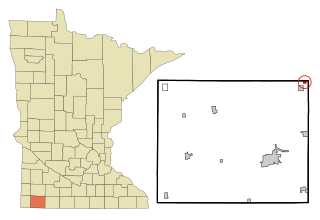
Murray County is a county in the U.S. state of Minnesota. The population was 8,179 at the 2020 census. Its county seat is Slayton.

Carlton is a city and the county seat of Carlton County, Minnesota, United States. The population was 948 at the 2020 census. The town sits on the northwestern edge of Jay Cooke State Park.

Chisago City is a city in Chisago County, Minnesota, United States, approximately 35 miles northeast of downtown Minneapolis–Saint Paul. The population was 4,967 at the 2010 census.

Baxter is a city in Crow Wing County, Minnesota, United States. The population was 8,612 at the 2020 census. It is part of the Brainerd Micropolitan Statistical Area.

Twin Lakes is a city in Freeborn County, Minnesota, United States, near Albert Lea. The population was 134 at the 2020 census.

Lake Lillian is a city in Kandiyohi County, Minnesota, United States. The population was 238 at the 2010 census.

Flensburg is a city in Morrison County, Minnesota, United States. The population was 216 at the 2020 census.

Sargeant is a city in Mower County, Minnesota, United States. The population was 63 at the 2020 census.

Chandler is a town in Murray County, Minnesota, United States. The population was 279 at the 2020 census.

Dovray is a city in Murray County, Minnesota, United States. The population was 58 at the 2020 census.
Dovray Township is a township in Murray County, Minnesota, United States. The population was 167 at the 2000 census. Dovray is located in Southwest Minnesota on the eastern side of Murray County. It is five minutes from Currie, fifteen minutes from Lake Shetek State Park, and twenty minutes northeast of Slayton.

Hadley is a city in Murray County, Minnesota, United States. The population was 54 at the 2020 census.
Shetek Township is a township in Murray County, Minnesota, United States. The population was 313 at the 2000 census.

Slayton is a city in and the county seat of Murray County, Minnesota, United States. The population was 2,013 at the 2020 census.

The Lakes is an unincorporated community and census-designated place (CDP) in Murray County, Minnesota, United States located north of Currie and south of Garvin. The population was 590 at the 2020 census. The community is centered about Lake Shetek, the largest lake in southwestern Minnesota. The lake and the community are located in parts of four townships in Murray County: Lake Sarah, Shetek, Murray, and Mason.

Dundee is a city in Nobles County, Minnesota, United States. The population was 73 at the 2020 census.

Denham is a city in Pine County, Minnesota, United States. The population was 37 at the 2020 census.

Starbuck is a city in Pope County, Minnesota, United States. The population was 1,365 at the 2020 census. The city is on the western shore of Lake Minnewaska.

Walnut Grove is a city in Redwood County, Minnesota, United States. The population was 871 at the 2010 census. Another name formerly associated with the area is Walnut Station.

Spring Lake Park is a city in Anoka and Ramsey counties in the state of Minnesota. The population was 6,412 at the 2010 census. The city is located mainly within Anoka County. Minnesota State Highways 47 and 65 and County Highway 10 are three of the main routes in the city.





















